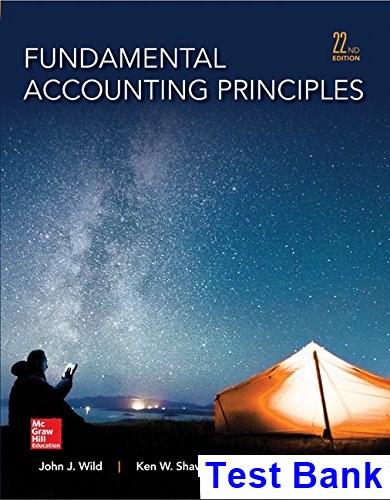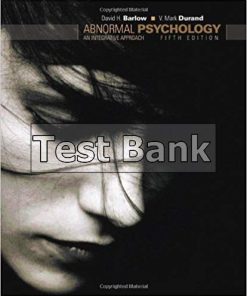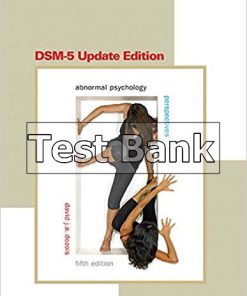Fundamental Accounting Principles 22nd Edition Wild Test Bank
You may also like
This is completed downloadable of Fundamental Accounting Principles 22nd Edition Wild Test Bank

Product Details:
- ISBN-10 : 0077862279
- ISBN-13 : 978-0077862275
- Author:
Enhancements in technology have changed how we live and learn. Working with learning resources across devices, whether smartphones, tablets, or laptop computers, empowers students to drive their own learning by putting increasingly intelligent technology into their hands. Whether the goal is to become an accountant, a businessperson, or simply an informed consumer of accounting information, Fundamental Accounting Principles has helped generations of students succeed. Its leadingedge accounting content, paired with state-of-the-art technology, supports student learning and elevates understanding of key accounting principles. Fundamental Accounting Principles also delivers innovative technology to help student performance. Our system for completing exercise and problem material takes accounting content to the next level, delivering assessment material in a more intuitive, less restrictive format that adapts to the needs of today’s students.
Table of Content:
Preface iii 1 Accounting in Business 2 Importance of Accounting 4 Users of Accounting Information 5 Opportunities in Accounting 6 Fundamentals of Accounting 8 Ethics?A Key Concept 8 Generally Accepted Accounting Principles 9 Sarbanes?Oxley 11 Transaction Analysis and the Accounting Equation 12 Accounting Equation 12 Transaction Analysis 13 Summary of Transactions 16 Financial Statements 17 Income Statement 18 Statement of Owner?s Equity 18 Balance Sheet 18 Statement of Cash Flows 18 Decision Analysis?Return on Assets 20 Appendix 1A Return and Risk Analysis 23 Appendix 1B Business Activities and the Accounting Equation 24 2 Analyzing and Recording Transactions 46 Analyzing and Recording Process 48 Source Documents 49 The Account and Its Analysis 49 Analyzing and Processing Transactions 52 Ledger and Chart of Accounts 52 Debits and Credits 53 Double-Entry Accounting 53 Journalizing and Posting Transactions 54 Analyzing Transactions?An Illustration 56 Accounting Equation Analysis 61 Trial Balance 63 Preparing a Trial Balance 63 Using a Trial Balance to Prepare Financial Statements 64 Decision Analysis?Debt Ratio 67 3 Adjusting Accounts and Preparing Financial Statements 90 Timing and Reporting 92 The Accounting Period 92 Accrual Basis versus Cash Basis 93 Recognizing Revenues and Expenses 93 Adjusting Accounts 94 Framework for Adjustments 94 Prepaid (Deferred) Expenses 95 Unearned (Deferred) Revenues 98 Accrued Expenses 99 Accrued Revenues 100 Links to Financial Statements 102 Adjusted Trial Balance 103 Preparing Financial Statements 103 Decision Analysis?Profit Margin 105 Appendix 3A Alternative Accounting for Prepayments 109 4 Completing the Accounting Cycle 134 Work Sheet as a Tool 136 Benefits of a Work Sheet 136 Use of a Work Sheet 136 Work Sheet Applications and Analysis 140 Closing Process 140 Temporary and Permanent Accounts 140 Recording Closing Entries 141 Post-Closing Trial Balance 142 Accounting Cycle 144 Classified Balance Sheet 145 Classification Structure 145 Classification Categories 145 Decision Analysis?Current Ratio 147 Appendix 4A Reversing Entries 151 5 Accounting for Merchandising Operations 176 Merchandising Activities 178 Reporting Income for a Merchandiser 178 Reporting Inventory for a Merchandiser 179 Operating Cycle for a Merchandiser 179 Inventory Systems 179 Accounting for Merchandise Purchases 180 Trade Discounts 180 Purchase Discounts 181 Purchase Returns and Allowances 182 Transportation Costs and Ownership Transfer 183 Accounting for Merchandise Sales 184 Sales of Merchandise 185 Sales Discounts 185 Sales Returns and Allowances 186 Completing the Accounting Cycle 187 Adjusting Entries for Merchandisers 188 Preparing Financial Statements 188 Closing Entries for Merchandisers 188 Summary of Merchandising Entries 188 Financial Statement Formats 190 Multiple-Step Income Statement 191 Single-Step Income Statement 192 Classified Balance Sheet 192 Decision Analysis?Acid-Test and Gross Margin Ratios 193 Appendix 5A Periodic (and Perpetual) Inventory System 198 Appendix 5B Work Sheet?Perpetual System 202 6 Inventories and Cost of Sales 222 Inventory Basics 224 Determining Inventory Items 224 Determining Inventory Costs 225 Inventory Controls and Taking a Physical Count 225 Inventory Costing under a Perpetual System 226 Inventory Cost Flow Assumptions 226 Inventory Costing Illustration 227 Specific Identification 227 First-In, First-Out 229 Last-In, First-Out 229 Weighted Average 230 Financial Statement Effects of Costing Methods 231 Consistency in Using Costing Methods 232 Valuing Inventory at LCM and the Effects of Inventory Errors 233 Lower of Cost or Market 233 Financial Statement Effects of Inventory Errors 234 Decision Analysis?Inventory Turnover and Days? Sales in Inventory 236 Appendix 6A Inventory Costing under a Periodic System 241 Appendix 6B Inventory Estimation Methods 245 7 Accounting Information Systems 264 Fundamental System Principles 266 Control Principle 266 Relevance Principle 266 Compatibility Principle 267 Flexibility Principle 267 Cost-Benefit Principle 267 Components of Accounting Systems 267 Source Documents 268 Input Devices 268 Information Processors 268 Information Storage 268 Output Devices 269 Special Journals in Accounting 269 Basics of Special Journals 270 Subsidiary Ledgers 270 Sales Journals 271 Cash Receipts Journal 275 Purchases Journal 277 Cash Disbursements Journal 278 General Journal Transactions 280 Technology-Based Accounting Systems 280 Computer Technology in Accounting 280 Data Processing in Accounting 281 Computer Networks in Accounting 281 Enterprise Resource Planning Software 281 Decision Analysis?Segment Return on Assets 282 Appendix 7A Special Journals under a Periodic System 286 8 Cash and Internal Controls 310 Internal Control 312 Purpose of Internal Control 312 Principles of Internal Control 313 Technology and Internal Control 314 Limitations of Internal Control 315 Control of Cash 316 Cash, Cash Equivalents, and Liquidity 317 Control of Cash Receipts 317 Control of Cash Disbursements 319 Banking Activities as Controls 323 Basic Bank Services 323 Bank Statement 325 Bank Reconciliation 326 Decision Analysis?Days? Sales Uncollected 329 Appendix 8A Documents in a Voucher System 332 Appendix 8B Control of Purchase Discounts 335 9 Accounting for Receivables 352 Accounts Receivable 354 Recognizing Accounts Receivable 354 Valuing Accounts Receivable 357 Estimating Bad Debts Expense 361 Notes Receivable 364 Computing Maturity and Interest 364 Recognizing Notes Receivable 365 Valuing and Settling Notes 366 Disposing of Receivables 367 Selling Receivables 367 Pledging Receivables 367 Decision Analysis?Accounts Receivable Turnover 368 10 Plant Assets, Natural Resources, and Intangibles 384 SECTION 1?PLANT ASSETS 386 Cost Determination 387 Land 387 Land Improvements 388 Buildings 388 Machinery and Equipment 388 Lump-Sum Purchase 388 Depreciation 389 Factors in Computing Depreciation 389 Depreciation Methods 390 Partial-Year Depreciation 394 Change in Estimates for Depreciation 395 Reporting Depreciation 395 Additional Expenditures 396 Ordinary Repairs 397 Betterments and Extraordinary Repairs 397 Disposals of Plant Assets 397 Discarding Plant Assets 398 Selling Plant Assets 398 SECTION 2?NATURAL RESOURCES 400 Cost Determination and Depletion 400 Plant Assets Used in Extracting Resources 401 SECTION 3?INTANGIBLE ASSETS 401 Cost Determination and Amortization 401 Types of Intangibles 402 Decision Analysis?Total Asset Turnover 404 Appendix 10A Exchanging Plant Assets 407 11 Current Liabilities and Payroll Accounting 426 Characteristics of Liabilities 428 Defining Liabilities 428 Classifying Liabilities 428 Uncertainty in Liabilities 429 Known (Determinable) Liabilities 430 Accounts Payable 430 Sales Taxes Payable 430 Unearned Revenues 431 Short-Term Notes Payable 431 Payroll Liabilities 433 Multi-Period Known Liabilities 436 Estimated Liabilities 437 Health and Pension Benefits 437 Vacation Benefits 438 Bonus Plans 438 Warranty Liabilities 438 Multi-Period Estimated Liabilities 439 Contingent Liabilities 439 Accounting for Contingent Liabilities 440 Reasonably Possible Contingent Liabilities 440 Decision Analysis?Times Interest Earned Ratio 441 Appendix 11A Payroll Reports, Records, and Procedures 444 Appendix 11B Income Taxes 450 12 Accounting for Partnerships 470 Partnership Form of Organization 472 Characteristics of Partnerships 472 Organizations with Partnership Characteristics 473 Choosing a Business Form 474 Basic Partnership Accounting 475 Organizing a Partnership 475 Dividing Income or Loss 475 Partnership Financial Statements 477 Admission and Withdrawal of Partners 478 Admission of a Partner 478 Withdrawal of a Partner 480 Death of a Partner 481 Liquidation of a Partnership 481 No Capital Deficiency 482 Capital Deficiency 483 Decision Analysis?Partner Return on Equity 484 13 Accounting for Corporations 498 Corporate Form of Organization 500 Characteristics of Corporations 500 Corporate Organization and Management 501 Stockholders of Corporations 502 Basics of Capital Stock 503 Common Stock 504 Issuing Par Value Stock 504 Issuing No-Par Value Stock 505 Issuing Stated Value Stock 505 Issuing Stock for Noncash Assets 506 Dividends 507 Cash Dividends 507 Stock Dividends 508 Stock Splits 510 Preferred Stock 510 Issuance of Preferred Stock 511 Dividend Preference of Preferred Stock 511 Convertible Preferred Stock 513 Callable Preferred Stock 513 Reasons for Issuing Preferred Stock 513 Treasury Stock 514 Purchasing Treasury Stock 514 Reissuing Treasury Stock 515 Retiring Stock 516 Reporting of Equity 516 Statement of Retained Earnings 516 Statement of Stockholders? Equity 517 Reporting Stock Options 517 Decision Analysis?Earnings per Share, Price-Earnings Ratio, DividendYield, and Book Value per Share 518 14 Long-Term Liabilities 542 Basics of Bonds 544 Bond Financing 544 Bond Trading 545 Bond-Issuing Procedures 546 Bond Issuances 546 Issuing Bonds at Par 546 Bond Discount or Premium 547 Issuing Bonds at a Discount 547 Issuing Bonds at a Premium 550 Bond Pricing 552 Bond Retirement 553 Bond Retirement at Maturity 553 Bond Retirement before Maturity 553 Bond Retirement by Conversion 554 Long-Term Notes Payable 554 Installment Notes 554 Mortgage Notes and Bonds 556 Decision Analysis?Debt Features and the Debt-to-Equity Ratio 557 Appendix 14A Present Values of Bonds and Notes 561 Appendix 14B Effective Interest Amortization 563 Appendix 14C Issuing Bonds between Interest Dates 565 Appendix 14D Leases and Pensions 567 15 Investments and International Operations 584 Basics of Investments 586 Motivation for Investments 586 Short-Term versus Long-Term 586 Classification and Reporting 587 Accounting Basics for Debt Securities 587 Accounting Basics for Equity Securities 588 Reporting of Noninfluential Investments 589 Trading Securities 589 Held-to-Maturity Securities 590 Available-for-Sale Securities 590 Reporting of Influential Investments 591 Investment in Securities with Significant Influence 591 Investment in Securities with Controlling Influence 593 Accounting Summary for Investments in Securities 593 Decision Analysis?Components of Return on Total Assets 594 Appendix 15A Investments in International Operations 599 16 Reporting the Statement of Cash Flows 620 Basics of Cash Flow Reporting 622 Purpose of the Statement of Cash Flows 622 Importance of Cash Flows 622 Measurement of Cash Flows 623 Classification of Cash Flows 623 Noncash Investing and Financing 625 Format of the Statement of Cash Flows 625 Preparing the Statement of Cash Flows 626 Cash Flows from Operating 628 Indirect and Direct Methods of Reporting 628 Application of the Indirect Method of Reporting 629 Summary of Adjustments for Indirect Method 634 Cash Flows from Investing 635 Three-Stage Process of Analysis 635 Analysis of Noncurrent Assets 635 Analysis of Other Assets 636 Cash Flows from Financing 637 Three-Stage Process of Analysis 637 Analysis of Noncurrent Liabilities 637 Analysis of Equity 638 Proving Cash Balances 639 Decision Analysis?Cash Flow Analysis 639 Appendix 16A Spreadsheet Preparation of the Statement of Cash Flows 643 Appendix 16B Direct Method of Reporting Operating Cash Flows 646 17 Analysis of Financial Statements 672 Basics of Analysis 674 Purpose of Analysis 674 Building Blocks of Analysis 675 Information for Analysis 675 Standards for Comparisons 676 Tools of Analysis 676 Horizontal Analysis 676 Comparative Statements 676 Trend Analysis 679 Vertical Analysis 681 Common-Size Statements 681 Common-Size Graphics 683 Ratio Analysis 685 Liquidity and Efficiency 685 Solvency 689 Profitability 690 Market Prospects 692 Summary of Ratios 692 Decision Analysis?Analysis Reporting 694 Appendix 17A Sustainable Income 697 18 Managerial Accounting Concepts and Principles 718 Managerial Accounting Basics 720 Purpose of Managerial Accounting 720 Nature of Managerial Accounting 721 Managerial Decision Making 723 Managerial Accounting in Business 723 Managerial Cost Concepts 725 Types of Cost Classifications 725 Identification of Cost Classification 727 Cost Concepts for Service Companies 727 Reporting Manufacturing Activities 728 Manufacturer?s Balance Sheet 728 Manufacturer?s Income Statement 729 Flow of Manufacturing Activities 732 Manufacturing Statement 733 Decision Analysis?Cycle Time and Cycle Efficiency 735 19 Job Order Cost Accounting 760 Job Order Cost Accounting 762 Cost Accounting System 762 Job Order Production 762 Events in Job Order Costing 763 Job Cost Sheet 764 Job Order Cost Flows and Reports 765 Materials Cost Flows and Documents 765 Labor Cost Flows and Documents 767 Overhead Cost Flows and Documents 769 Summary of Cost Flows 770 Adjustment of Overapplied or Underapplied Overhead 773 Underapplied Overhead 773 Overapplied Overhead 774 Decision Analysis?Pricing for Services 774 20 Process Cost Accounting 796 Process Operations 798 Comparing Job Order and Process Operations 799 Organization of Process Operations 799 GenX Company?An Illustration 799 Process Cost Accounting 801 Direct and Indirect Costs 801 Accounting for Materials Costs 802 Accounting for Labor Costs 802 Accounting for Factory Overhead 803 Equivalent Units of Production 805 Accounting for Goods in Process 805 Differences in Equivalent Units for Materials, Labor, and Overhead 805 Process Costing Illustration 806 Step 1: Determine Physical Flow of Units 807 Step 2: Compute Equivalent Units of Production 807 Step 3: Compute Cost per Equivalent Unit 808 Step 4: Assign and Reconcile Costs 808 Transfers to Finished Goods Inventory and Cost of Goods Sold 811 Effect of Lean Business Model on Process Operations 812 Decision Analysis?Hybrid Costing System 813 Appendix 20A FIFO Method of Process Costing 816 21 Cost Allocation and Performance Measurement 840 SECTION 1?ALLOCATING COSTS FOR PRODUCT COSTING 842 Overhead Cost Allocation Methods 842 Two-Stage Cost Allocation 842 Activity-Based Cost Allocation 844 Comparison of Two-Stage and Activity-Based Cost Allocation 846 SECTION 2?ALLOCATING COSTS FOR PERFORMANCE AND EVALUATION 847 Departmental Accounting 847 Motivation for Departmentalization 848 Departmental Evaluation 848 Departmental Reporting and Analysis 848 Departmental Expense Allocation 849 Direct and Indirect Expenses 849 Allocation of Indirect Expenses 850 Departmental Income Statements 851 Departmental Contribution to Overhead 854 Responsibility Accounting 855 Controllable versus Direct Costs 856 Responsibility Accounting System 856 Decision Analysis?Investment Center Return on Total Assets 858 Appendix 21A Joint Costs and Their Allocation 861 22 Cost-Volume-Profit Analysis 880 Identifying Cost Behavior 882 Fixed Costs 882 Variable Costs 883 Mixed Costs 883 Step-Wise Costs 884 Curvilinear Costs 884 Measuring Cost Behavior 885 Scatter Diagrams 885 High-Low Method 886 Least-Squares Regression 887 Comparison of Cost Estimation Methods 887 Using Break-Even Analysis 888 Contribution Margin and Its Measures 888 Computing Break-Even Point 888 Preparing a Cost-Volume-Profit Chart 890 Making Assumptions in Cost-Volume-Profit Analysis 890 Applying Cost-Volume-Profit Analysis 891 Computing Income from Sales and Costs 892 Computing Sales for a Target Income 892 Computing the Margin of Safety 893 Using Sensitivity Analysis 894 Computing Multiproduct Break-Even Point 895 Decision Analysis?Degree of Operating Leverage 896 23 Master Budgets and Planning 914 Budget Process 916 Strategic Budgeting 916 Benchmarking Budgets 916 Budgeting and Human Behavior 917 Budgeting as a Management Tool 917 Budgeting Communication 917 Budget Administration 918 Budget Committee 918 Budget Reporting 918 Budget Timing 918 Master Budget 920 Master Budget Components 920 Operating Budgets 922 Capital Expenditures Budget 925 Financial Budgets 926 Decision Analysis?Activity-Based Budgeting 929 Appendix 23A Production and Manufacturing Budgets 935 24 Flexible Budgets and Standard Costs 952 SECTION 1?FLEXIBLE BUDGETS 954 Budgetary Process 954 Budgetary Control and Reporting 954 Fixed Budget Performance Report 955 Budget Reports for Evaluation 956 Flexible Budget Reports 956 Purpose of Flexible Budgets 956 Preparation of Flexible Budgets 957 Flexible Budget Performance Report 958 SECTION 2?STANDARD COSTS 959 Materials and Labor Standards 960 Identifying Standard Costs 960 Setting Standard Costs 960 Cost Variances 961 Cost Variance Analysis 961 Cost Variance Computation 961 Materials and Labor Variances 962 Overhead Standards and Variances 965 Setting Overhead Standards 965 Using Overhead Cost Variance Analysis 966 Computing Overhead Cost Variances 967 Extensions of Standard Costs 970 Standard Costs for Control 970 Standard Costs for Services 970 Standard Cost Accounting System 970 Decision Analysis?Sales Variances 972 25 Capital Budgeting and Managerial Decisions 996 SECTION 1?CAPITAL BUDGETING 998 Methods Not Using Time Value of Money 999 Payback Period 999 Accounting Rate of Return 1001 Methods Using Time Value of Money 1002 Net Present Value 1003 Internal Rate of Return 1005 Comparison of Capital Budgeting Methods 1007 SECTION 2?MANAGERIAL DECISIONS 1008 Decisions and Information 1008 Decision Making 1008 Relevant Costs 1009 Managerial Decision Scenarios 1009 Additional Business 1009 Make or Buy 1011 Scrap or Rework 1012 Sell or Process 1013 Sales Mix Selection 1013 Segment Elimination 1014 Qualitative Decision Factors 1015 Decision Analysis?Break-Even Time 1016 Appendix A Financial Statement Information A-1 Best Buy A-2 Circuit City A-19 Apple Computer A-24 Appendix B -Time Value of Money B-1 Glossary G Credits CR Index IND-1 Chart of Accounts CA
People Also Search:
fundamental accounting principles
fundamental accounting principles 22nd edition wild
fundamental accounting principles 22nd edition testbank download pdf
fundamental accounting principles 22nd edition download scribd
fundamental accounting principles 22nd edition












